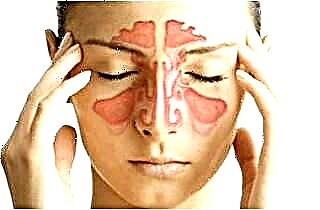Among diseases of the nasopharynx of allergic origin, rhinitis is confidently leading - an inflammation of the mucous membrane lining the nasal cavity. Most allergy sufferers regularly encounter it.
Rhinitis of an allergic nature can turn into a threatening disease - allergic sinusitis. This happens in people with weak immunity, anomalies of the internal structure of the nose, as well as changes in the paranasal sinuses of an inflammatory nature. This is an inflammation of the mucous membrane lining the maxillary (maxillary) sinuses, accompanied by their hyperemia and edema. The disease is allergic in nature. Almost never occurs in isolation. Some of the most prominent symptoms include frequent sneezing, nasal congestion, mucous discharge, and headache. Treatment of allergic sinusitis should be timely and adequate.
Where does it come from
Inflammation, which suddenly covers the maxillary sinuses, like any other allergy, is usually classified as an autoimmune pathology. After all, it is directly related to the incorrect reaction of the immune system to a variety of substances - from food, aerosols, medicines, and so on. Often, allergic sinusitis is caused by those pathogens that penetrate the body through the respiratory tract. In other words, they are in the air.
 So, the disease can be triggered by:
So, the disease can be triggered by:
- pollen from flowering plants;
- pet hair;
- household dust;
- dust mites and their waste products;
- aromas of cosmetics and smells of cleaning and washing chemicals;
- fumes of volatile substances (perfumes, air fresheners).
In extremely rare cases, allergic sinusitis develops after the use of any product, which causes an individual hypersensitivity reaction in an individual person. This disease usually manifests itself as a skin rash or rhinitis. However, the maxillary sinuses are not inflamed.
In general, this problem may appear only in those who have previously suffered from recurrent allergic reactions in various forms. That is, in those who are susceptible to such pathologies or have genetic inheritance.
As already mentioned, sinusitis always develops after rhinitis. Any allergen in the air first gets on the villi, which abound in the nasal mucosa, and only then gets to the paranasal maxillary sinuses.
Often, both rhinitis and sinusitis appear during the period of active flowering of various plants (spring-summer) or during drought, when the number of calls to an allergist doubles.
Symptoms
The main cause of allergic sinusitis is the penetration of an allergen into the body. Each person reacts to an allergen differently. One begins to experience unbearable itching, the other gets covered with rashes, the third suffers from a severe runny nose. Therefore, it can be argued that the symptoms of this disease will be different for each person. Although their origin is the same.
So, the main signs indicating the development of this type of sinusitis are presented:
 Incessant nasal congestion. This symptom appears when the allergen has already hit the nasal mucosa, causing very severe swelling. At the same time, due to the fact that the nose is always stuffed up, the ability to perceive and distinguish odors disappears. In part, this also affects the taste buds - problems with the sense of taste arise.
Incessant nasal congestion. This symptom appears when the allergen has already hit the nasal mucosa, causing very severe swelling. At the same time, due to the fact that the nose is always stuffed up, the ability to perceive and distinguish odors disappears. In part, this also affects the taste buds - problems with the sense of taste arise.- Headache resulting from the above symptom. A severe headache attack can be triggered by frequent blowing of your nose and regular use of drops to narrow blood vessels. Not every anesthetic drug can relieve this pain syndrome.
- Weakness, fatigue, chills and general unimportant health - this is how the body reacts to the invasion of allergens.
- A runny nose lasting for over a month. At the same time, the volume of nasal discharge does not decline.
- An increase in body temperature.
- Pain in the area of the paranasal sinuses.
- Photophobia.
- Discharge from the nasal cavities with purulent contents.
- Night cough, the cause of which is the release of mucus into the respiratory system.
- Conjunctivitis.
Signs indicating the development of inflammation of the maxillary sinuses due to an allergic reaction are very similar to the symptoms of common sinusitis. The main difference is that they are provoked by different pathogens.
Note that sinusitis of allergic origin is a consequence of the influence of an irritant on the body and, in fact, an allergy in a neglected form. To effectively treat this disease, competent differential diagnosis is very important.
Distinctive features of allergic sinusitis
As already mentioned, sinusitis, which develops as a result of an allergic reaction, is very similar to ordinary sinusitis. This creates serious difficulties in diagnosing the disease. However, it has several features that allow it to be diagnosed and distinguished from its “brother”. The disease is characterized by:
 The frequency of exacerbations. Allergies are usually a seasonal nuisance. It can be triggered by the flowering of a plant or some other pathogen. Therefore, one should not rush to identify a simple sinusitis. First, it is necessary to analyze whether a runny nose appears systematically and whether it is tied to a specific season. At the same time, you need to remember what happens to the nose during contact with a pet.
The frequency of exacerbations. Allergies are usually a seasonal nuisance. It can be triggered by the flowering of a plant or some other pathogen. Therefore, one should not rush to identify a simple sinusitis. First, it is necessary to analyze whether a runny nose appears systematically and whether it is tied to a specific season. At the same time, you need to remember what happens to the nose during contact with a pet.- Strengthening of symptoms at the time of direct contact with the pathogen. If a person suffers from such sinusitis, he has an exacerbation of all symptoms when, for example, he walks past a blooming ragweed. The disease will also worsen if he enters the room where the animals are (with an allergy to wool).
- The impossibility of using standard methods of treatment that are effective against common sinusitis. Note that doctors prefer to treat sinusitis with antibacterial drugs. However, with an allergic form of the disease, they will be absolutely useless.
The listed signs help to distinguish sinusitis, which has developed as a result of an allergic reaction, from the usual inflammation of the maxillary sinuses. However, the diagnosis should only be carried out by an experienced specialist. Trying to do this yourself is not recommended.
And finally
Of course, sinusitis of an allergic nature is an extremely unpleasant disease. In addition, it is much more difficult to cure it than ordinary sinusitis. The point is that it is very difficult to find the exact stimulus that triggers an allergic reaction. Therefore, self-medication is not recommended. It is necessary to consult a doctor at the first symptoms. He will conduct the necessary examination and establish the correct diagnosis.
 To prevent the development of allergic sinusitis, preventive measures must be taken. Of course, it is extremely difficult to completely stop contacting the allergen, and in some cases it is completely impossible. But you can stimulate the immune system so that it begins to adequately respond to various allergens. To do this, you should adhere to the principles of proper healthy nutrition, do not forget about regular physical activity and hardening of the body.
To prevent the development of allergic sinusitis, preventive measures must be taken. Of course, it is extremely difficult to completely stop contacting the allergen, and in some cases it is completely impossible. But you can stimulate the immune system so that it begins to adequately respond to various allergens. To do this, you should adhere to the principles of proper healthy nutrition, do not forget about regular physical activity and hardening of the body.
You also need to visit a doctor as soon as the first symptoms of rhinitis appear. The specialist will select a competent treatment regimen and, if necessary, correct it. Then the disease can be avoided.
If the history is burdened with allergies, it is advisable to give up smoking and keeping any animals at home, do wet cleaning every day, and also minimize the use of various aerosols and household cleaning detergents to a minimum.

 Incessant nasal congestion. This symptom appears when the allergen has already hit the nasal mucosa, causing very severe swelling. At the same time, due to the fact that the nose is always stuffed up, the ability to perceive and distinguish odors disappears. In part, this also affects the taste buds - problems with the sense of taste arise.
Incessant nasal congestion. This symptom appears when the allergen has already hit the nasal mucosa, causing very severe swelling. At the same time, due to the fact that the nose is always stuffed up, the ability to perceive and distinguish odors disappears. In part, this also affects the taste buds - problems with the sense of taste arise. The frequency of exacerbations. Allergies are usually a seasonal nuisance. It can be triggered by the flowering of a plant or some other pathogen. Therefore, one should not rush to identify a simple sinusitis. First, it is necessary to analyze whether a runny nose appears systematically and whether it is tied to a specific season. At the same time, you need to remember what happens to the nose during contact with a pet.
The frequency of exacerbations. Allergies are usually a seasonal nuisance. It can be triggered by the flowering of a plant or some other pathogen. Therefore, one should not rush to identify a simple sinusitis. First, it is necessary to analyze whether a runny nose appears systematically and whether it is tied to a specific season. At the same time, you need to remember what happens to the nose during contact with a pet.

